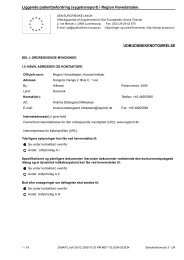Territorial Review Copenhagen - Region Hovedstaden
Territorial Review Copenhagen - Region Hovedstaden
Territorial Review Copenhagen - Region Hovedstaden
You also want an ePaper? Increase the reach of your titles
YUMPU automatically turns print PDFs into web optimized ePapers that Google loves.
169<br />
Aside from a regional focus, the involvement of the national government is<br />
key in building the next generation of <strong>Copenhagen</strong>‘s affordable housing<br />
stock, given the limited planning powers Danish municipalities have at their<br />
disposal to pursue affordable housing. Given this predicament, the next<br />
section outlines possible strategies at the municipal, regional, and national<br />
levels to facilitate housing production and its diversity.<br />
Increasing the supply of modest cost housing: options at the<br />
municipal level<br />
Particular relief is needed for the low end of the rental market. Low<br />
turnover rates, long waiting lists, the amalgamation of smaller units into<br />
larger units, and the conversion of private rental housing to housing societies<br />
have constrained the private rental market. Prices in the city of <strong>Copenhagen</strong><br />
have increased at a meteoric pace: from 1997 to 2007, the average price for<br />
an owner-occupied apartment nearly quadrupled. 17 The question of adequate<br />
and affordable housing in the city of <strong>Copenhagen</strong> occupies a central place in<br />
political debate. The City of <strong>Copenhagen</strong> might consider additional tools<br />
that transcend policies in the 2009 City Development Plan: 18 the reduction<br />
or elimination of fees for new rental housing, streamlining the development<br />
approval process and reducing particular taxes for inexpensive rental<br />
developments. Given the slow pace of construction and an accelerating<br />
economic recession, governments in the <strong>Copenhagen</strong> metro region could<br />
design policies to reduce the barriers of entry into the homebuilding<br />
industry. Facilitating entry has the potential to increase housing production.<br />
Research from Vancouver, for example, shows that builders respond to<br />
market uncertainty by delaying construction, an effect that is counteracted<br />
when there were many other competitors in a locality (Mayer and<br />
Sommerville, 2002; cited in Ball, 2006). Finally, the City of <strong>Copenhagen</strong><br />
could more proactively encourage the development of smaller ―accessory<br />
dwelling units‖ commonly known as in-law units, carriage houses or<br />
secondary apartments. This could be done through making it easier for<br />
owners to construct roof-top apartments, expand existing buildings, and<br />
facilitating the conversion of commercial properties into residential<br />
buildings (Erlandsen et al., 2006). Such a strategy, though already pursued<br />
by the City of <strong>Copenhagen</strong>, may have particular appeal to outlying<br />
municipalities whose homes are generally newer and more prone to<br />
accommodate the stress of additional floors and physical alterations. 19<br />
More favourable rental housing construction economies could also be<br />
created. The <strong>Copenhagen</strong> metropolitan region‘s construction sector has<br />
capacity constraints that could be relieved. Part of the increase in the cost of<br />
housing relates to the rising prices for electrical work and plumbing, which

















